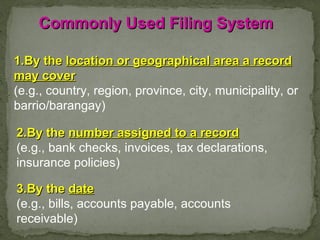Effective filing and recording system 2
- 2. What are Records? Are compiled, recorded or stored information regardless of format ( paper, book, film, electronic data, etc.) and characteristics. They are a part of and result from business activities and provide evidence of those activities.
- 4. Records are information asset • are a valuable asset. • are the memory of any agency and serve to perpetuate or preserve knowledge of events, facts, actions, or ideas. Records support accountability • are evidence of what happened, why and by whom. • reinforce accountability and provide an essential means to meet legal, financial and accountability requirements.
- 5. Importance of Records • Ensure continuity and consistency in administration; • Assist officials and their successors in making informed policy and program judgments; • Provide information required by higher authorities to oversee the organization’s activities; and • Document the agency's organization, structure, and achievements .
- 6. Two Sources of Records Records created by the agency itself. These are records prepared by the agency for its own use and for its business transactions. Records received by the agency. These are records received from other agencies – government or private.
- 7. Filing is the classification and arrangement of records in a systematic way. is also the storage of papers according to a set arrangement.
- 8. Commonly Used Filing System 1. By the name of an individual Personal files (201) contain individual record of personal information about every employee in the agency. This is arranged chronologically – the latest action being the last entry in the folder. •Appointment records •Employee service records •Personal data records •Pension plan; applications, claims and correspondence •Scholarship records •Leave records •Performance records
- 9. Commonly Used Filing System 2.By the subject matter that usually covers all activities and functions of the agency and not specific to any single employee Administrative files (major subject heading) • Annual reports (primary classification) • Minutes of Meeting (primary classification) • System and procedure records (primary classification) Budget files (major subject heading) • Budget preparations (primary classification) • Budget appropriations (primary classification) • Work and Financial plans (primary classification)
- 10. Commonly Used Filing System by the subject matter… Financial and Accounting Files Legal Files Procurement and Supply Files Training Files
- 11. Commonly Used Filing System 1.By the location or geographical area a record may cover (e.g., country, region, province, city, municipality, or barrio/barangay) 2.By the number assigned to a record (e.g., bank checks, invoices, tax declarations, insurance policies) 3.By the date (e.g., bills, accounts payable, accounts receivable)
- 12. Workshop 1: Knowing your records 1. On a manila paper, make 3 columns: Column 1: List all your church records Column 2: Identify the source of each record Column 3: Indicate if record should be classified by subject matter, name, location, number, or date 2. Post output on the wall (30 minutes)
- 13. What is Records Management? Is the efficient and systematic control of the creation, receipt, maintenance, use, storage, protection, and disposition of records required for the continuance of agency business and operation.
- 14. Workshop 2: Why manage records? • Brainstorm on the benefits of managing records • Write them in another manila paper • Post output on the wall (20 minutes)
- 15. Why Manage Records To Control the Creation and Growth of Records To Reduce Operating Costs To Improve Efficiency and Productivity To Assimilate New Records Management Technologies To Safeguard Vital Information To Support Better Management Decision Making To Foster Professionalism in Running the Business
- 16. Records maybe divided into three categories according to its usefulness: Active files – records currently and frequently use. Semi-Active files – records that are occasionally needed for reference or legally required to be retained. Inactive files – records that outlived its usefulness and ready to be disposed.
- 17. Elements of Records Management Creation of records Retention and Maintenance of records Retention period is the life of the record. It is the specific length of time established and approved by competent authority after which a given record is ready for permanent storage or disposal. Records have varying period of usefulness. It is necessary to determine when they should be retired (disposed) and for how long they should be retained.
- 18. Elements of Records Management Access to records • making records accessible and useable to users within and outside the agency. • setting up and implementing access rules & restrictions to protect records from unauthorized access for security and privacy reasons. Preservation of records Disposal of records
- 19. Process of Records Disposal Appraisal – appraising which records need to be retained and for how long. This includes identifying records with on-going value as archives. Sentencing – implementing retention decisions and disposal actions to records. This includes documenting transfer and destruction of records. Destruction – includes documenting records destroyed and the authority by which they were destroyed. Transfer of records – transferring of records with permanent value/usefulness to an archives institution. This includes documenting records that have been transferred .
- 20. What are archives? are records appraised as having continuing value because they meet an ongoing (legal, evidential or research) need to the organization. also refers to the place where records of continuing value are stored, preserved, and used.
- 21. Records Retention Schedule Churches should have their own written record retention policy. The retention schedule for both physical and electronic documents can be classified based on the period of time they are useful to the church.
- 22. What is Records Management? Is the efficient and systematic control of the creation, receipt, maintenance, use, storage, protection, and disposition of records required for the continuance of agency business and operation.






















